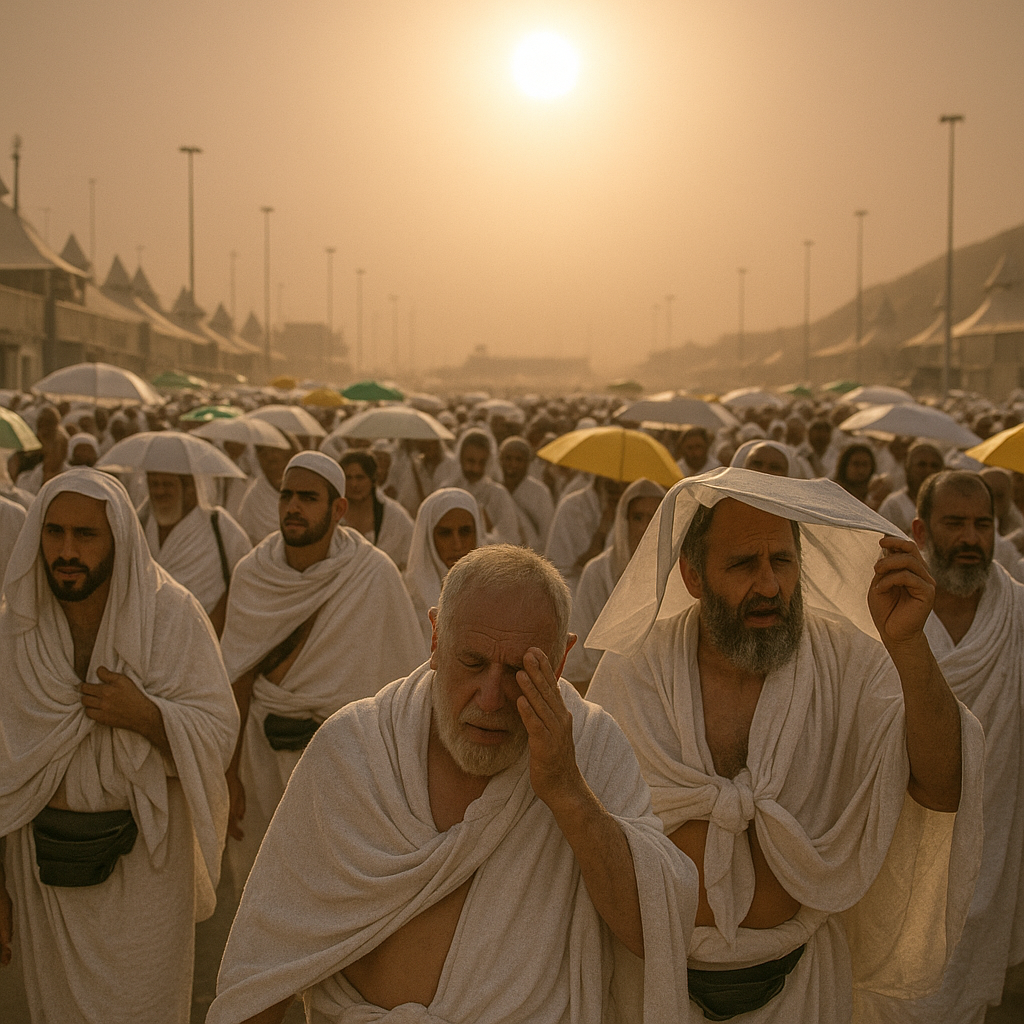
🌡️ Heat Challenge & Safety Measures
Hajj 2025 kicked off amid dangerously high temperatures, with daily highs hovering between 41–47 °C (106–117 °F) travelandtourworld.comen.wikipedia.org+5euronews.com+5travelandtourworld.com+5euronews.com+11ap.org+11timesofindia.indiatimes.com+11. This came after the devastating 2024 heatwave that claimed over 1,300 lives preventionweb.net.
To protect pilgrims:
- Officials distributed umbrellas, urged light clothing, and discouraged sun exposure during peak hours dailysabah.com+9ap.org+9apnews.com+9.
- Hundreds of cooling units, misting stations, and shaded areas (totalling over 50,000 m²) were deployed dailysabah.com.
- The Grand Mosque featured the world’s largest air conditioning system operating between 22–24 °C arabnews.com+5euronews.com+5time.com+5.
🛂 Crowd Management & Permit Crackdown
Saudi Arabia enforced stricter entry rules—over 269,000 individuals were turned away for missing permits, and unauthorized pilgrims faced fines up to $5,000 or deportation apnews.com+11apnews.com+11the-independent.com+11. The goal: reduce overcrowding and prevent past tragedies the-independent.com+1arabnews.com+1.
Inside Mecca, over 1.4 million registered pilgrims navigated the holy sites under heavy-ground and drone surveillance economictimes.indiatimes.com+15apnews.com+15dailysabah.com+15. Smart wearable devices monitored vitals to detect early signs of heat stress apnews.com+15the-independent.com+15apnews.com+15.
🤖 Tech, Infrastructure & Logistics
Saudi authorities showcased a blend of tradition and innovation:
- AI-powered drones with thermal cameras monitored crowd flows and helped with fire safety arabnews.comtime.com+1ft.com+1.
- The Al‑Mashaaer metro and buses—more than 20,000 vehicles—shuttled pilgrims between key sites arabnews.com.
- Wearable smart-cards and the Nusuk app provided pilgrims real-time guidance and support travelandtourworld.com.
Additional upgrades included:
- 50,000 new trees planted for shade time.com+2ft.com+2arxiv.org+2.
- Seven new medical facilities added; healthcare staff increased by ~60% travelandtourworld.com+1apnews.com+1.
- Sustainability focus: hydrogen-powered buses and solar-powered cooling travelandtourworld.com.
❌ Policy Changes & Pilgrim Profile
- Child ban under 12 (some say under 15) enforced for safety amid the heat and crowd density ft.com+5ap.org+5apnews.com+5.
- Preference given to first-time pilgrims, aiming for fair access across countries preventionweb.net+15time.com+15travelandtourworld.com+15.
- Quota and payment adjustments helped some nations facing cost barriers—Hajj packages range $4,000–$20,000 preventionweb.net+15apnews.com+15reddit.com+15.
Pilgrim numbers:
- Approx. 1.5 million from 150+ countries travelandtourworld.com.
- Indonesia sent over 220,000 pilgrims alone euronews.com+4saudivisaoffice.com+4en.wikipedia.org+4.
🙏 Pilgrim Reactions & Reflections
Despite the heat and tight regulations, many described their experience as “peaceful and safe.” Abdul Majid Ati from the Philippines stated:
“This is really a blessing from Allah… peaceful and safe in this place.” dailysabah.com
A Nigerian pilgrim added he never left home without sunglasses due to the “very, very, very hot” weather apnews.com+2dailysabah.com+2ap.org+2.
🔍 What’s Next?
With Hajj over, Saudi Arabia has resumed visa issuance for tourist and Umrah pilgrims—e‑visa services reactivated on June 10, 2025 economictimes.indiatimes.com. Meanwhile, early preparations are already underway for Hajj 2026 travelandtourworld.com. And thanks to the lunar calendar, next year’s Hajj will shift to cooler seasons—spring/winter—until 2042 euronews.com+15saudimoments.com+15youtube.com+15.
📺 Video Recap (Visual Summary)
🧭 Final Thoughts
Hajj 2025 was historic—not only for Saudi Arabia’s innovative safety systems but also as a testing ground for climate resilience and pilgrim care. From the largest AC installations to smart drones and heat protocols, the pilgrimage set a high bar for future events.
Key Takeaways for Your Readers:
- The heat remained Hajj’s biggest threat, countered with massive cooling efforts.
- Technology played a central role—from drones to apps and smart cards.
- Policy updates (age limits, permit enforcement, first-timer preference) shaped both safety and fairness.
click BISMILLAH MEKKAH